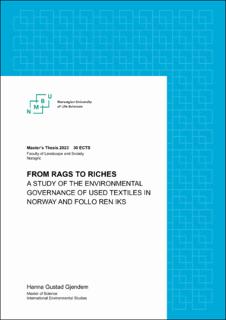| dc.description.abstract | This master’s thesis explores the topic of used textile management in Norway. Around 50% of all used textiles from Norwegian households end up in the residual waste. As Norway plans to develop a circular economy, resources such as used textiles must be exploited to their fullest extent to lower their environmental footprint and keep them cycling back into the economy. At the local level, municipal waste companies are trying to participate in the circular management of used textiles by capturing these resources separately from other waste fractions. This thesis aims to understand what causes suboptimal management of used textiles in Norway and how these challenges should be addressed at the national level, which is the first research objective. The second objective is a case study of inter-municipal waste company at the local level, Follo Ren IKS. We explored how they can implement a system for separate collection of used textiles that captures a larger share of the used textiles their inhabitants dispose of. These objectives were addressed through qualitative interviews with expert informants involved in used textile management and a survey data collection conducted on inhabitants of the Follo Region. Through the environmental governance systems framework, the findings suggest that the main causes of suboptimal management of used textiles in Norway are due to lacking infrastructure, lacking technologies, insufficient collaboration amongst all the economic actors, and a lack of responsibility placed on the textile producers. For the second objective, the theories of human action combined with policy measures and instruments allowed for the systematic interpretation of the survey data. The findings indicate that certain demographic groups amongst the Follo region inhabitants are more likely to dispose of their used textiles in the residual waste, hindering any chance of reuse or recycling. The groups which stood out were men, people under 30, single-person households, people with higher education, and households with one child or no children. The inhabitants were positive about the idea of implementing a pick-up solution for used textiles, which could capture a larger share of the textiles going to waste. Such a system should be structured to be easy to use and strongly communicated to the inhabitants, to increase separate collection. | |
